UK wine production has scaled up considerably in recent years, but one new producer views grapes as being part of its mixed farming enterprise.
KEEPING IT BRIEF
- A Berkshire downland farm has diversified into viticulture
- Specialist contractors and advisors have been engaged to help with the project.
- The family run the vineyard alongside a large mixed farming enterprise
Farms looking to find a more sustainable future for their business often consider diversifying into other crops, but in the UK, grapes would be an unusual choice. However, that is the path that has been taken by the Carlisle family at Rowles Farm, West Illsley. Eight years after deciding to plant a vineyard, the first bottles of the farm’s wine went on sale this summer.

“My twin brothers Will and Tom and I are the third generation here at Rowles Farm,” explains Georgie Carlisle-Smith. “Our grandfather moved here from Swindon in 1969 after his land was cut through by the development of the M4. He took out a three-generation tenancy from the Lockinge Estate and later purchased more land.”
Sons Peter and David then farmed the land, but in 2015 the family was given four weeks’ notice that the farm was for sale.
“We were up against large farming companies so our tenancy was under threat, so we took out a 25-year mortgage to buy it, but it became clear that we’d need to diversify in order for the business to support four families.”
What way to go
Georgie began to look at opportunities for viticulture in 2017, seeing the development of the industry in the UK; wineries from France, Spain and Italy were also buying land in England to plant vines.
The first step was to gather data on soils and climate – in particular frost – so Georgie purchased a Soil Moisture Sense weather station and consultant Vineworks carried out soil sampling to find out if there was a suitable site on the farm for a vineyard. The sensors gathered data for four years while the ideal site was chosen on the farm’s south facing hills.
“Sites that Dad thought would be ideal surprised us by turning out to have the worst frost pockets!” Georgie recalls. The Berkshire downland farm is notably windy which helps in minimising frosts, and varieties for cool temperatures were chosen. Planting got underway in 2021, with Bacchus and Pinot Noir varieties, followed by Seyval Blanc in 2022, using the services of specialist contractor Sam Barnes. A tree windbreak was also established.

The right people
Vine management is a specialised and highly labour-intensive process, Georgie explains: “We are highly reliant on our consultant Ed Mitcham, who plans the programme and sources and manages contract labour, with a team of 30 workers from Romania and Bulgaria. This includes winter pruning and then shoot selection (choosing the most prominent shoots) and bud pruning in the spring.”
Another skilled task essential for production from young vines is careful removal of grapes in summer to leave just two bunches per shoot, avoiding damage to the developing branches.
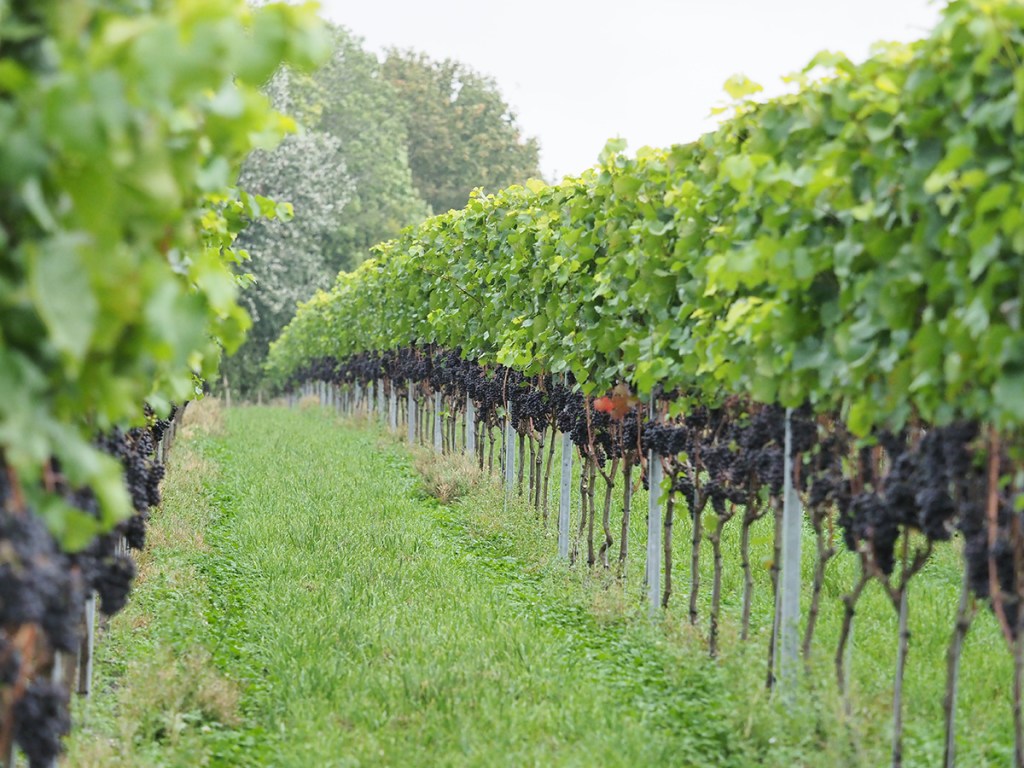
Significant investment in equipment has also been required, and Georgie explains that the aim is to buy one machine a year.
Battling weather
Frost is one of the biggest challenges for viticulturists, leading to buds and grapes shrivelling, so two Tow and Blow portable frost fans are used to move warm air rising from the soil back into the vineyard, oscillating around the rows.
“They are activated by temperature probes, but occasionally variable temperatures in the vineyard mean that they don’t come on when needed. We have been known to go into the vines in our pyjamas to check them!” she says.
The weather station from Soil Moisture Sense continues to monitor solar, wind, temperature and rainfall conditions in the vineyard and updates a phone app every 15 mins, so data is always to hand. Changing climate may mean that the prevalence of frosts is less than in the past, but Georgie points out that severe cold can decimate the crop.
“We’re lucky that we have some pony paddocks at the bottom of the hill below the vineyard so frost can flow out of it rather than getting trapped in a hollow. Other vineyards use frost candles which are good for hard frosts but can be very costly. We decided that in the early days of the business it’s better to lose some yield, and the fans did a good job this year.”
Flash flooding and hail are other threats; the extreme dry conditions of this year have clearly suited the crop well, but in 2022, drought meant that the Carlisles were considering irrigating the newly-established vines.
“We’d had to water the windbreak trees, but Sam Barnes convinced us that the vines would push their roots down to access moisture and they did,” she says.
Sandra Carlisle comments that the farm’s loam over chalk soil, has served them well, being resistant to drought.
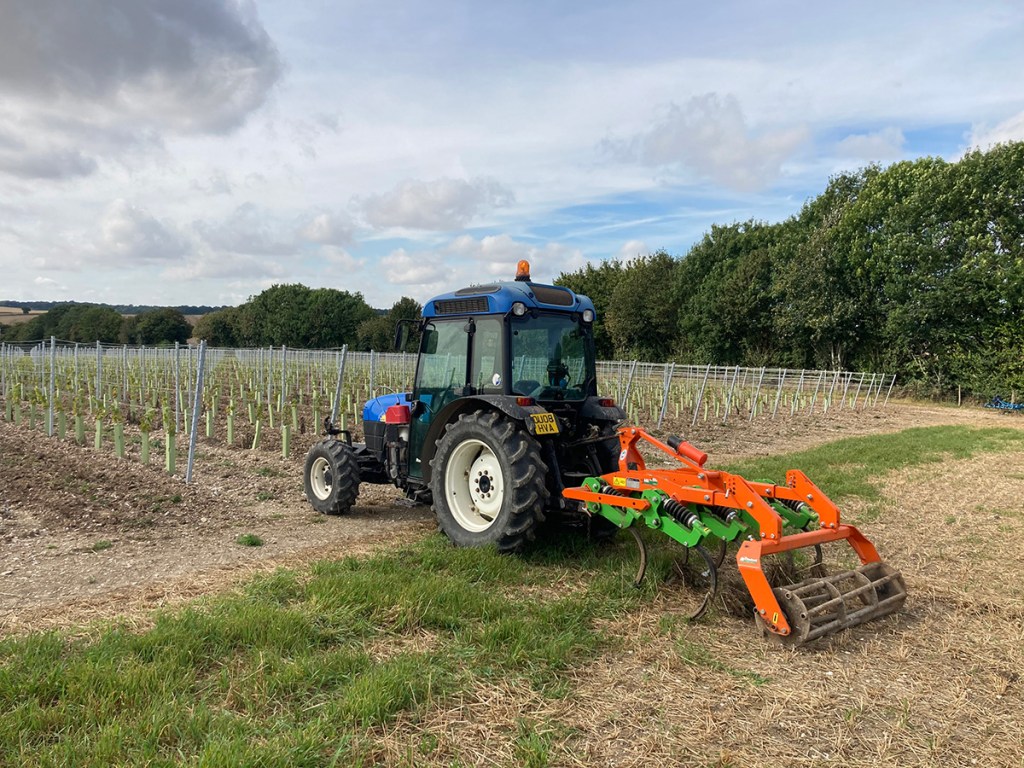
Mechanical means
A New Holland T4.100F narrow tractor is used to power implements within the 2.20m wide rows, drilling cover crops between the vines, mowing, spreading poultry litter and importantly, pulling a specialised sprayer.

“We need to spray every 10 days to two weeks, mainly nutrients such as seaweed, sulphur, magnesium, iron and calcium but also some herbicides and fungicides,” explains Georgie. “Ed was providing a contract spraying service, but our ethos is to keep applications in-house so that we can manage timings and chemical stocks more precisely.”
On advice from Ed and from Sam Barnes, the Berthoud Win’Air 1000 trailed sprayer was chosen. It uses telescopic booms to spray three rows of vines (two full rows plus two half rows) using nozzles mounted on vertical Air Drive drop legs. The diffusers are positioned to offer optimum coverage of leaves and grapes and control is via a specialised version of Berthoud’s Berlogic terminal, offering section control and electronic spray regulation.
The spraying outfit is just 1.9m wide to fit down the rows and spraying normally takes place at 5:00 to 8:00am to minimise wind disturbance.
“It’s very simple to operate and maintain; we will recoup the £35,000 cost of the sprayer compared to paying contract fees,” Georgie comments.
First fruit
In 2023 the first harvest yielded four tonnes, sent to another vineyard for blending; in 2024, a notably poor year for the industry with a relentlessly wet harvest, the first production harvest brought 12 tonnes. Yields for 2025 totalled an impressive 78 tonnes and the 6.5ha of vines could potentially produce 100 tonnes.
A significant step in the process this year was the move to mechanical harvesting for some 30 tonnes of the crop.

“We started out with volunteers to handpick, but even with last year’s relatively poor harvest, it soon became obvious that we were running out of time. We ended up asking Ed Mitcham to find extra labour from his contract workers.”
The crop was harvested by Sam Barnes with his Pellenc 890 Grapes’line trailed machine.
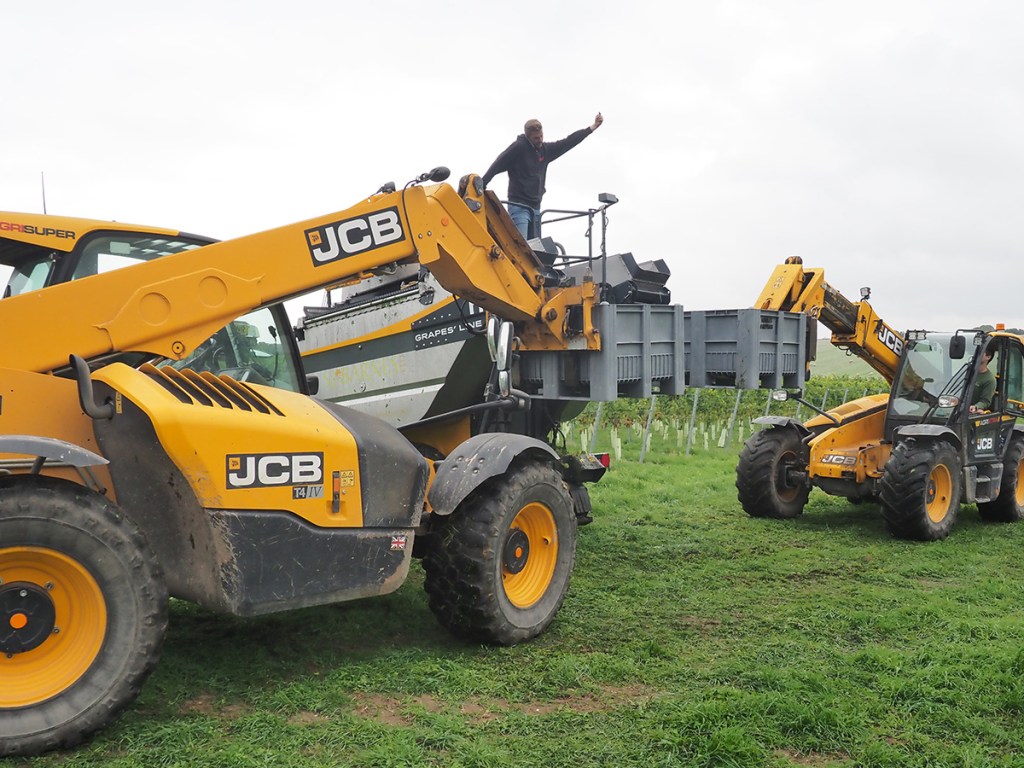
“It’s an excellent set up at Rowles Farm with two telehandlers ready to empty the pair of 1,800-litre bins into dolavs (crates) and with wide headlands for easy turning so that the harvester can work to capacity,” Sam comments. “The vineyard has progressed really well since planting, and the quality of the grapes is very high.”

The Pellenc is one of a pair operated by Sam across the south of England; he has harvested 200ha this season.
The end product
Grapes go to contract winemaker Itasca Wines in nearby Hampshire; two thirds are sold to other wineries while the remainder – 1,200 bottles in 2024 – are labelled as Rowles Farm’s own product and sold to local pubs and farm shops.
There was a significant marketing and admin workload before the first bottles went on sale: from developing a brand – including via an Instagram account with 14,000 followers to date – to understanding the requirements of Food Standards and of gaining a Premise Licence to sell wine from the farm.
In the mix
Viticulture dovetails around duties on the rest of the farm, where there is 600ha in hand, 300ha farmed for David Carlisle – with his livestock skills traded for arable work by Peter, Georgie, Will and Tom – plus 100ha for a neighbour.

Winter wheat, winter or spring barley and oilseed rape form the arable rotation, along with grass leys for 30 fattening cows, 800 breeding ewes and 600 ewe lambs. Lambing takes place in March and May, and Georgie says: “We breed our own replacements and the sheep benefit the arable ground, grazing off cover crops. It’s definitely worthwhile, although I have to remind myself of that at lambing, as it’s so labour intensive!”
SFI options include companion cropping and cover crops, plus zero insecticides, while the farm also benefits from grain merchant ADM’s incentives for min-till and direct drilling. The move to min-till leaves a Köckerling cultivator on hand when needed; an 8.0m Horsch Avatar direct drills where possible. The plough has left the farm and the Bateman RB35 30m sprayer has become more important.
“We were lucky enough to get the oilseed rape in just ahead of the first showers in August,” comments Peter. “Winter barley was drilled after a two-year ley in September, with the wheat fitting in around the grape harvest.”
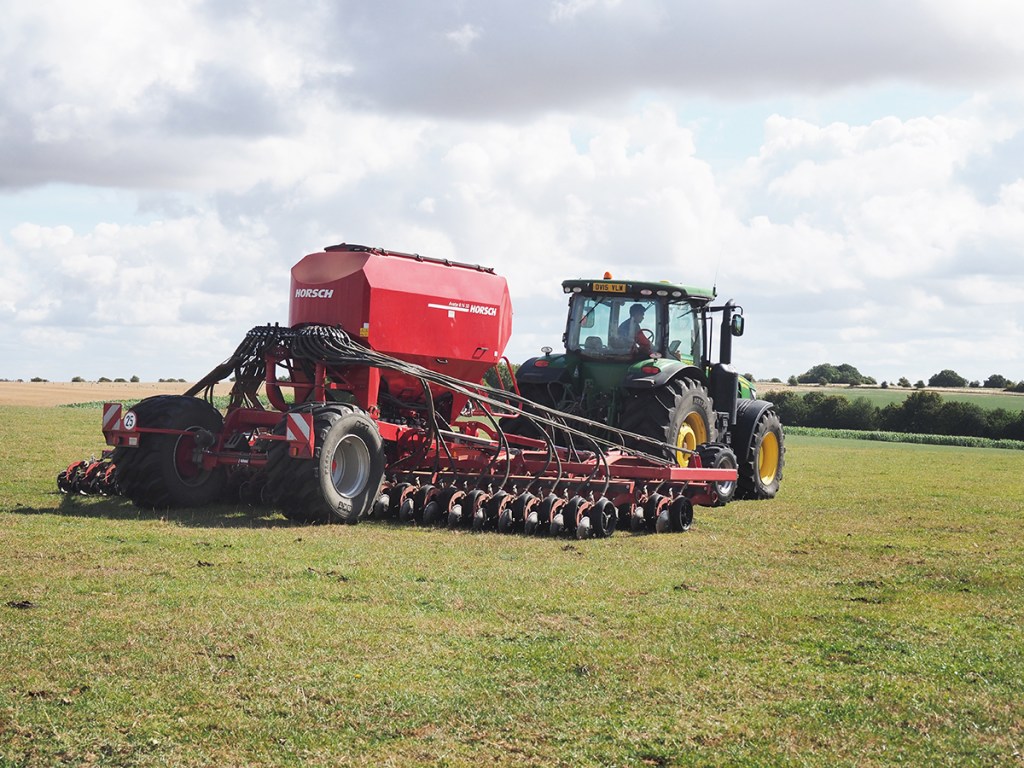
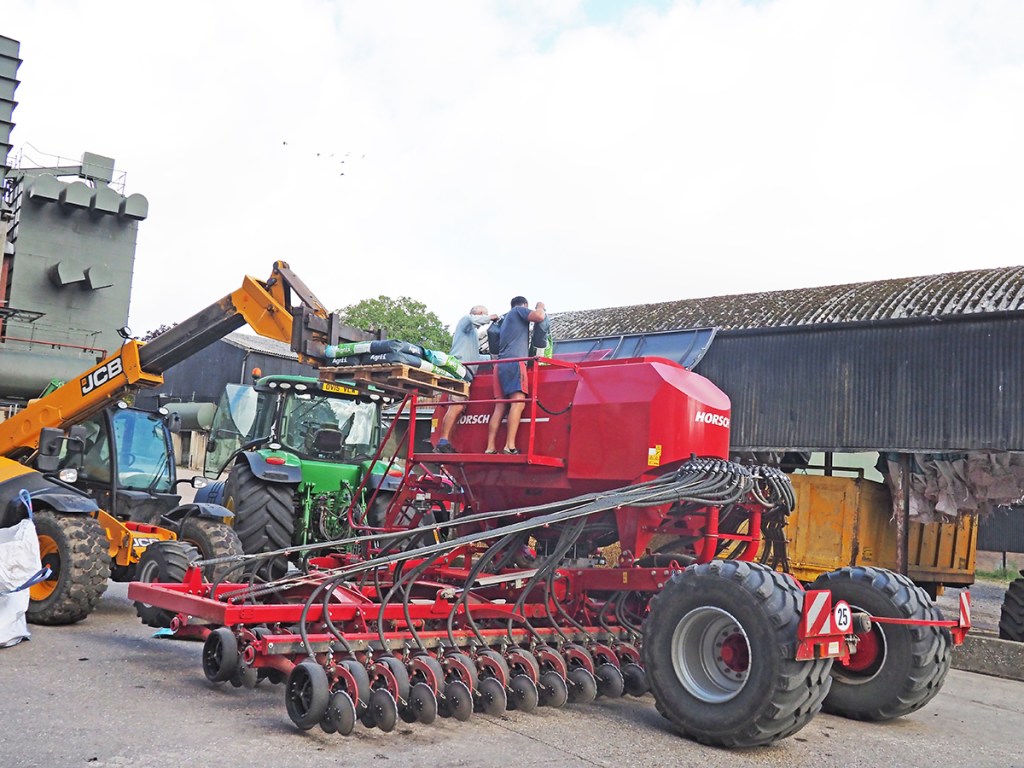
Simplifying cultivations also helps with the labour challenge on the farm, which employs no outside staff. Georgie, Will and Tom also have the added pressure of all having become parents in the past year!
What about expansion?
As for the future, Georgie says that there are no immediate plans to build a winery. “We are still farming, and the grapes are very much a crop, so maximising their capacity is the priority.”
Expanding the vineyard is not off the table, but Georgie comments: “We purchased all our trellising before Covid, at a cost of £35,000/ha. It would be double that now. There’s also the issue of ensuring that we can manage it as a family.”
Additional profit from taking wine making in house would be one benefit of a winery, but the duty paid on English wine is still a ‘killer’, the family say, making investment and extra staff costs challenging. Over-supply of grapes in a good year is another consideration: a solid contract is important for the security of the business.
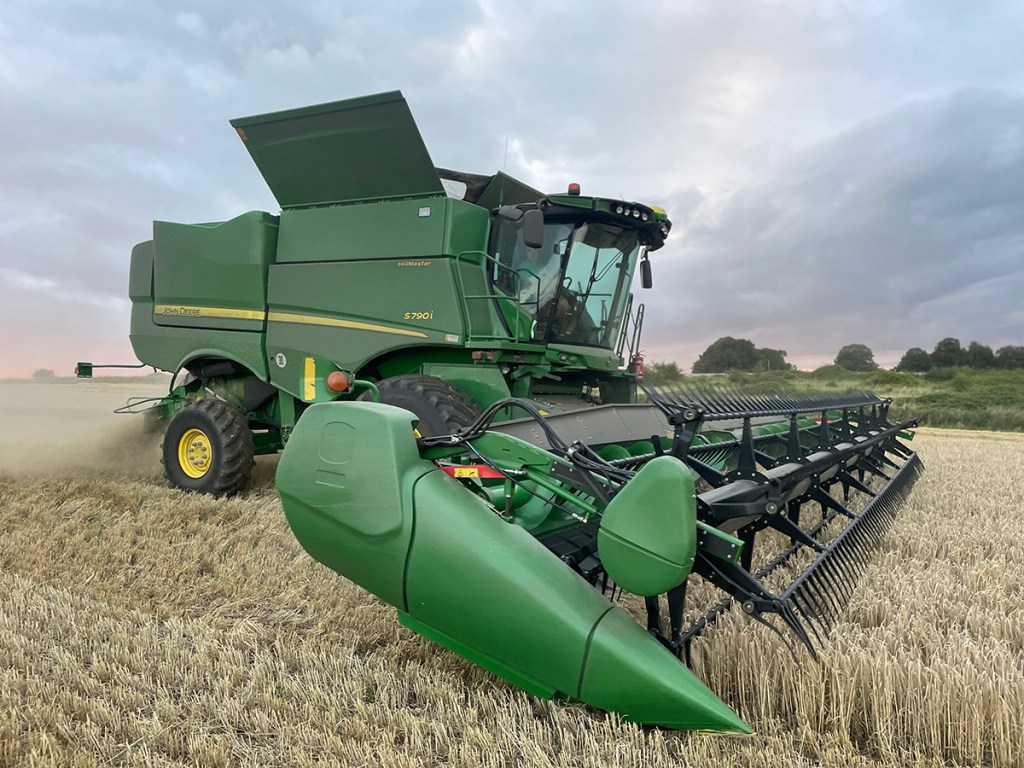
On the arable side, machinery costs continue to bite; the John Deere S790i combine will remain on the farm for a fifth year, when it would normally have been swapped. A more pressing need is to replace the 50-year-old conventional grain dryer, and discussions surround increasing barn capacity with a drying floor or a new dryer.
It’s a similarly considered approach to the vineyard, where taking a modern approach to one of the most traditional of crops, with phased investment in highly specialist equipment, has got a new enterprise off to a flying start.
Jane Carley
For more up-to-date farming news click here and subscribe now to profi and save.






